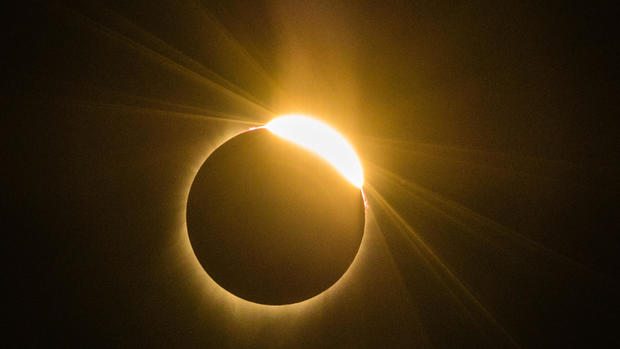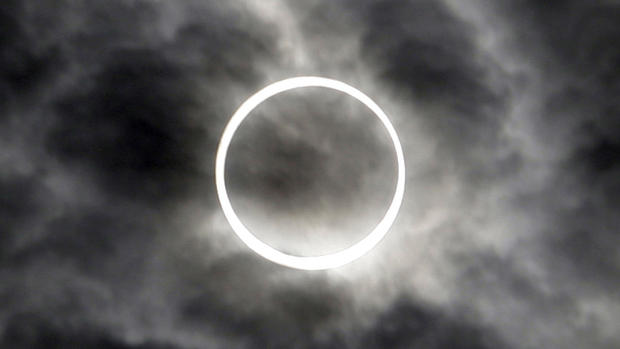Solar eclipse to darken skies Friday
The world is set to experience a total eclipse on Friday, although few people will see the eclipse in its total glory and North Americans will miss out entirely.
The total eclipse - when moon completely obscures our view of the sun - will happen mostly over the north Atlantic Ocean Friday morning and will only be visible in the Faroe Islands, located halfway between Iceland and the tip of Scotland, and Norway's Svalbard Islands.
Those remote islands are now destinations for scores of eclipse chasers and scientists like Jay Pasachoff at Williams College who see this as a unique opportunity to study the sun.
"We need good weather and we won't know until the last day whether we will get some holes in the clouds to see the eclipse," said Pasachoff, who was heading to Svalbard Wednesday and has seen more than 60 eclipses.
"Each one is tremendously exciting," he told CBS News. "They are all different and it is thrilling to be outdoors when the sky darkens so abruptly and so dramatically."
While a total eclipse will be a hard-to-catch sight, billions around the globe will be able to see a partial one, when the edge of the moon first intrudes into the solar disc. It will be visible in most of northern Africa, western Asia and parts of the Middle East. All of Europe will see a partial eclipse, though some will get a better view than others. In northern Scotland, the sun will appear 97 percent eclipsed, 84 percent in London, 75 percent in Paris, 65 percent in Madrid and 56 percent in Rome, according to the European Space Agency.
Viewers in North America will be out of luck, except for a select few who will see a partial eclipse in Saint John's, Newfoundland.
The next chance to see a total solar eclipse in the U.S. will come on Aug. 21, 2017.
During totality, the sun appears to have a wispy white halo, offering ground observers a rare direct view of its atmosphere or corona, normally kept out of sight by the intense brightness of the solar disc.
For scientists, this gives them a rare chance to directly observe the interactions between different layers of the sun's atmosphere, known as the photosphere, chromosphere and the solar corona.
"In the past, we needed to have the total eclipse to observe the chromosphere," Joe Zender, who is a project scientist on the European Space Agency's Proba-3, which launches in 2018 and will, among other things, study the sun's faint corona. "Even today in a spacecraft and especially on the ground, it's difficult to observe the chromosphere."
As part of this, Zender and other scientists said the data gathered helps them better understand such things as coronal mass ejections where bubbles of gas burst forth from the sun's corona and sometimes head to Earth.
The implications of such work became clear this week when Earth was hit by a severe solar storm, potentially disrupting power grids and GPS tracking while pushing the colorful northern lights farther south. Two blasts of magnetic plasma left the sun on Sunday, came together and arrived on Earth Tuesday, several hours earlier and much stronger than expected.
"We want to be able to understand these ejections and how they travel through space in all directions as part of finding out how to predict them," Pasachoff said.
Taking high-resolution images and measuring the spectrum of the corona, Pasachoff also is interested in sunspot activity and exploring whether, as some scientists have suggested, this phenomenon is going away.
"We have just passed the maximum of the sunspot cycle so it is interesting to see how the corona differs from what it was for the last couple of eclipses, which were at solar maximum, and whether we have some particular coronal mass ejections (we had two in 2013 during the eclipse) that we can study in detail," he said.
And while they only have a few minutes to do their work during an eclipse, Pasachoff said the opportunity was invaluable.
"If I were a heart surgeon and I told you that I could look inside a human heart two years ago for two minutes, would you be asking me why I wanted another two minutes?" said Pasachoff, who is also chair of the International Astronomical Union's working group on eclipses.
"It's the same as studying the sun's atmosphere. We get a glimpse for a few seconds every couple of years so there is always lots to see and study," he said. "Not only the sun, but also billions of other stars have similar atmospheres. So, what we learn about the sun in detail applies to all the other stars that we can't study so well."

